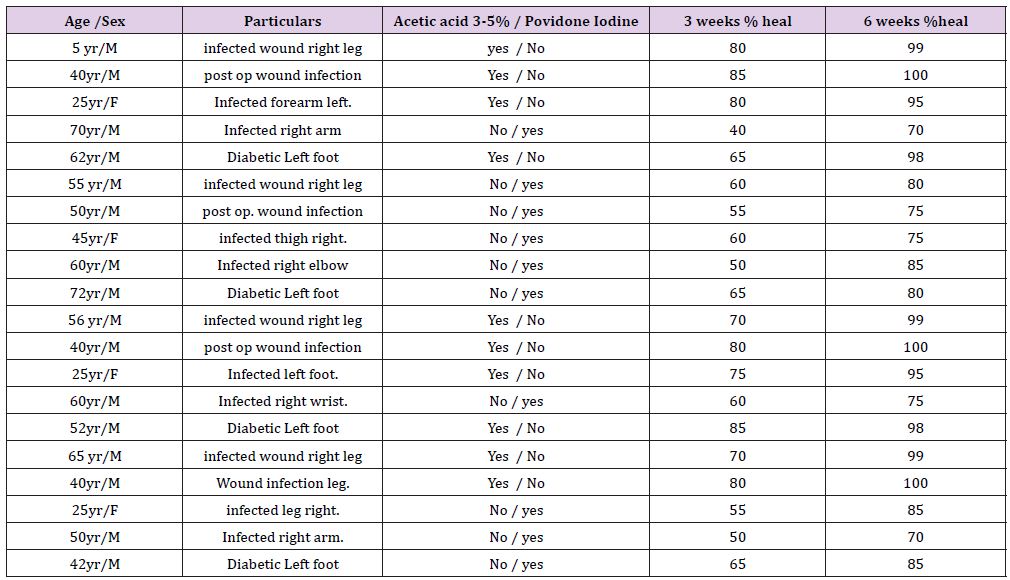Impact Factor : 0.548
- NLM ID: 101723284
- OCoLC: 999826537
- LCCN: 2017202541
SM Rabiul Islam*
Received: October 27, 2017; Published: November 01, 2017
Corresponding author: SM Rabiul Islam, Department of Orthopaedic Surgery, Raja Isteri Pengiran Anak Saleha Hospital, Brunei Darussalam
DOI: 10.26717/BJSTR.2017.01.000487
Aim: Infected surgical wounds of extremities increase patient mortality and morbidity, with extended hospital stay and significant economic burden. Bone and joint infections pose a formidable challenge to the orthopedic surgeon. Salvage therapy of infected wounds of the extremities using 5% acetic acid and providone iodine.
Objective: To determine outcome of infected surgical wounds treated with 5% acetic acid and povidone iodine, and to reduce burden of costly systemic antibiotic therapy and find out an alternate way of infected wound management.
Method: 20 patients 16 male and 4 female average age 45years range 25 to 65yeras with infected extremities wounds were treated in which half of the patients were treated by 5% acetic acid (Group A) and half were treated with povidone iodine (Group B).
Results: The average age of patients was 45 years with male to female ratio 4:1. In-group A the wound healing was 76% and in-group B it was 54% after three weeks. But at the end of 6th week 98% healing was seen in group A while 83% healing was seen in group B.
Conclusion: Surgical infected wounds of extremities treated with 5% acetic acid reduce patient morbidity, hospital stay and economic burden.
Abbrevation: CDC: Centers for Disease Control
Infected surgical wounds of extremities increase patient mortality and morbidity, with extended hospital stay and significant economic burden. Bone and joint infections pose a formidable challenge to the orthopedic surgeon [1]. The high success rate obtained with antibiotic therapy in most bacterial diseases has not been obtained in bone and joint infections because of the physiological and anatomical characteristics of bone. The overall surgical site infection rate has been estimated by the U.S. Centers for Disease Control and Prevention (CDC) to be 2.8% in the United States [2].
We evaluate the risk of infection in each patient by considering patient-dependent and surgeon-dependent factors. Patientdependent factors include nutrition, immunological status, and infection at a remote site. By physical and lab investigation. Surgeondependent factors include prophylactic antibiotics, skin and wound care, operating environment, surgical technique, and treatment of impending infections such as in open fractures. Simply stated, it is much easier to prevent an infection than it is to treat it. Most common pathogens responsible for wound infection in extremities are Staphylococcus aureas. Pseudomonas aeruginosa is a classic opportunistic pathogen with innate resistance to many antibiotics and disinfectants. It is the most difficult nosocomial pathogen to be eliminated from infection site [3]. The management of wound requires proper attention including medicinal and antiseptic dressings. This study was designed to see the role of 5% acetic acid and povidone iodine in extremities infected wounds.
For this study total 20 hospitalized patients with wound infection in extremities not responding to traditional therapy for more than10 days were selected for the study. We equally divided our sample randomize in selection, and first half group A and second half group B. Group A were treated by 3%-5% acetic acid and Group B were treated by povidone iodine for 6 (six) weeks, and observe the healing. We used the Outcome parameters were as:
i. patient morbidity and mortality
ii. wound healing
iii. number of debridements
iv. wound culture results
v. white blood cell count > 10,000 cells/ dl)
vi. pyrexia > 100°F
vii. Infection site pain
a. Study Design: Prospective comparative study design was used.
b. Setting: Department of Orthopedic surgery and Traumatology International Medical College and Hospital, Gushulia, Tongi, Gazipure. Bangladesh [4] (Table 1).
Table 1: Details of patients.

The average age of patients was 45 years with male to female ratio 4:1. In-group A the wound healing was 76% and in-group B it was 54% after three weeks. But at the end of 6th week 98% healing was seen in group a while 83% healing was seen in group B. Wounds were healed or were closed or were granulating follow-up. Number of debridements, wound cultures, white-blood-cells, and fever decreased after treatment began with 5% acetic acid [5-8].
Wound infection in extremities in hospitalized patients has always been problem to the clinicians. Traditional therapies with anti microbial agents have their own limitations because of multiple antibiotic resistances. The use of acetic acid and providone iodine has been reported from time to time as a topical agent for the treatment of extremity wound infection. Topical use of acetic acid at concentrations between 0.5 to 5% eliminated microorganism responsible for extremity wound infection. From the result of this study it is concluded that 5% acetic acid is non-toxic and superior to providone iodine. It is the best alternative when infection is caused by multiple antibiotic resistant strains and where there is shortage of therapeutic options [9-11].
Dressings with 5% acetic acid for infected wounds of the extremities yield good results.


